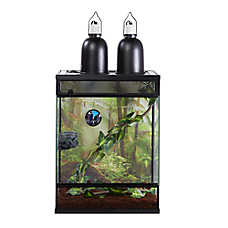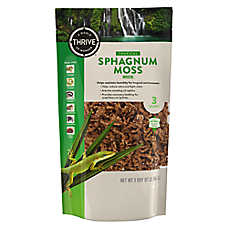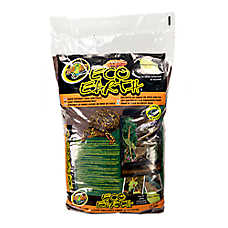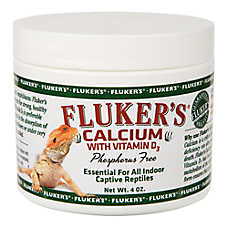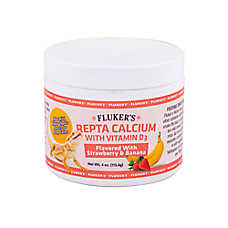White’s Tree Frog

In this Article
Whimsical White’s Tree Frogs
White’s tree frog, also known as a Dumpy tree frog, is a small amphibian native to New Zealand and Australia. These frogs are quite mellow and make wonderful pets for those looking to start their foray into frog keeping. White’s tree frogs are not as jumpy as some of their other frog cousins, and their beautiful green coloring make them visually very interesting. You’ll be looking at your new pet frog just as much as they will be looking at you!
White’s tree frog species profile
Size: White's tree frogs can grow up to 3-5" (7-11.5cm).
Lifespan: On average they live 10-16yrs, with some individual animals reaching 20 years!
Habitat: White's tree frogs are arboreal tropical animals. This means they spend their days in trees and enjoy a humid environment.
Behavior: While they can learn to tolerate limited handling, these frogs are better served as “display” pets. These delicate frogs are normally green but their color can vary widely depending on the frog’s health, environment and mood!
Temperament: While they can be housed in small groups, to prevent fighting we recommend housing alone or in small groups of 2-3 individuals of only females (one male can live with 1-2 females but may result in unwanted breeding.) They can be flighty and are liable to injure themselves if they try to escape being handled.
Note: Because White’s tree frog has porous skin, if you plan to handle your frog, it is recommended you wash your hands prior to handling or wear gloves in order to prevent your frog from absorbing any of the lotion or anything else that might be on your skin that could make your frog very sick
Setting up your white's tree frog habitat
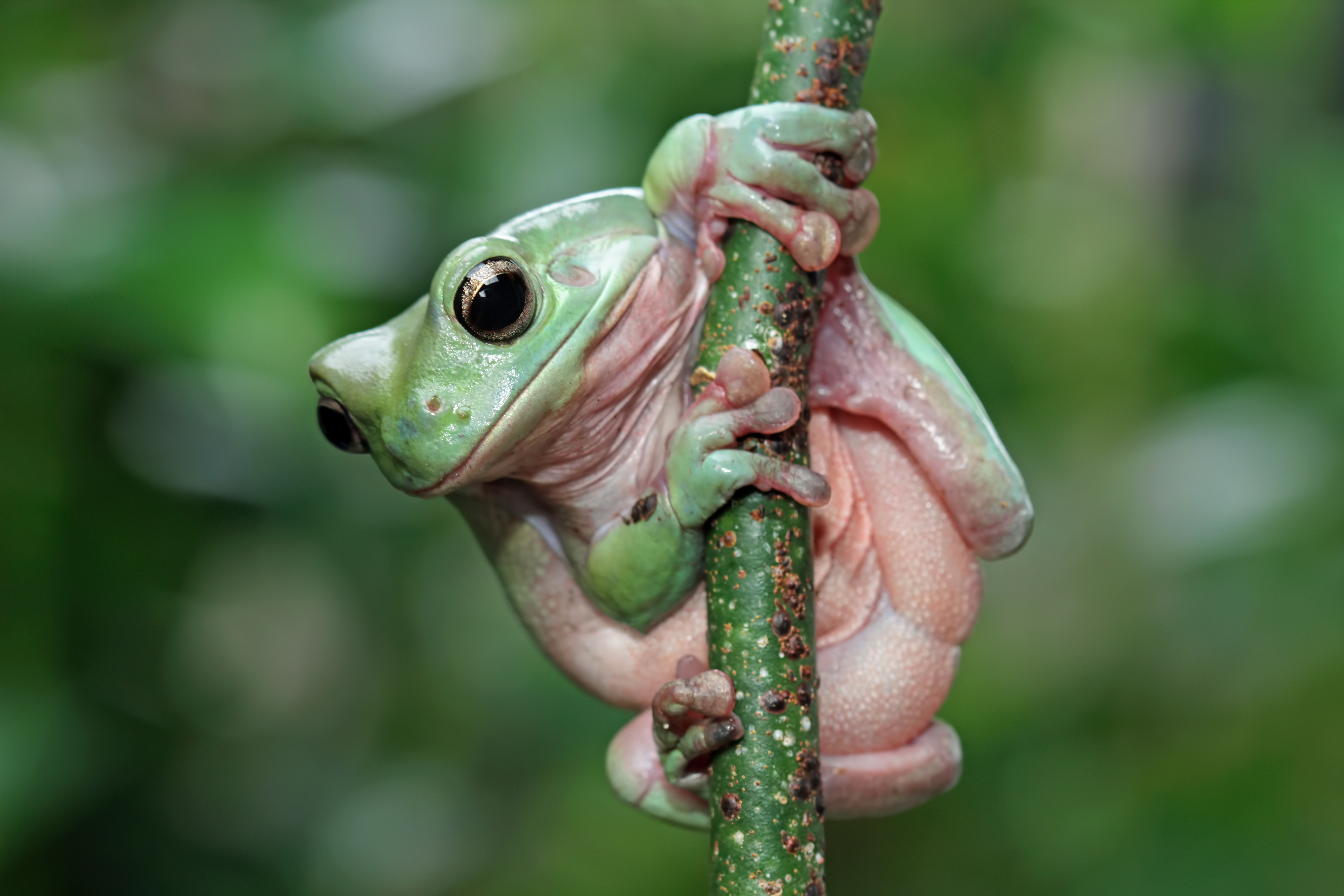
White’s tree frogs thrive in tall, humid enclosures filled with stable climbing structures. Their sensitive skin and tropical lifestyle require consistent heat, moisture, and clean conditions.
Enclosure size and layout
- Use a vertical terrarium that’s at least 30 gallons and 24 inches tall for two to three frogs
- Screened lids are essential for ventilation
- Line the floor with reptile carpet or a 2 to 3-inch mix of sphagnum moss and soil-based substrate like coconut fiber, peat moss, or reptile bark
- Spot clean daily, stir the bedding weekly, and fully replace monthly
Include stable, non-toxic climbing branches and plants:
- Offer both vertical and horizontal perches for movement and rest
- Use live or artificial décor that can handle moisture and won’t tip over easily
- Provide hiding spots to help your frog feel secure
Temperature and humidity
White’s tree frogs need a consistent temperature gradient (a warm end and a cooler end to their enclosure) and high humidity. Use a ceramic heat emitter or low-wattage heat bulb during the day and turn it off at night unless your room drops below 70°F.
Zone | Temperature |
Warm side range (top) | 80 to 85°F (24–29°C) |
Cool side range (bottom) | 75 to 80 (24 to 27) |
Nighttime range | 70 to 75°F (21–24°C) |
Humidity | 60 to 80 percent |
- Monitor with two thermometers (top and bottom) and a hygrometer
- Use a misting system, automatic fogger, or daily hand misting to maintain humidity
- Keep a large, shallow dish of dechlorinated water in the enclosure at all times for soaking and drinking
Lighting
- Set up your lighting outside the terrarium, over top the screened lid, so your frog has a warm area to bask in but cannot get so close to the bulb that they are burned.
- Many reptiles and amphibians benefit from having access to Low-wattage UVB lighting. UVB allows the body to synthesize vitamin D3 which is critical for absorption of calcium. Some daylight bulbs will be rated to also provide UVB, and some won’t so it is important to check. Providing low-intensity UVB light over the basking site is recommended.
- Frogs need a 12- hours light cycle to regulate their sleep cycle. Using a timer on your lighting makes this easy to accomplish
- Avoid high-output UVB bulbs, which may be too intense for tree frogs
For more setup help, see PetSmart’s Reptile & Amphibian Heating & Lighting and Setting Up a Reptile or Amphibian Habitat Care Guides.
What to feed your tree frog
White’s tree frogs are insectivores that prefer to hunt at night. Feeding in the evening aligns with their natural rhythms and supports healthy appetite and behavior.
Insect diet
- Offer gut-loaded insects such as crickets and dubia roaches as a staple
- Rotate in small amounts of mealworms, superworms, and waxworms for variety
- Juveniles should be fed daily; adults can be fed every other day
Always dust insects with:
- Calcium powder twice per week
- A reptile multivitamin once a week for juveniles and twice a month for adults (or as directed by your veterinarian)
What does “gut-loaded” mean?
Gut loading refers to feeding insects a nutritious, supplement-rich diet before offering them to your frog. This boosts the nutrient content of the prey, helping keep your frog healthy.
Gut loading refers to feeding insects a nutritious, supplement-rich diet before offering them to your frog. This boosts the nutrient content of the prey, helping keep your frog healthy.
Water and hydration
- Provide a large, shallow water dish with dechlorinated water at all times
- Your frog may both soak and drink from this dish
- Clean and refill the water daily
Important:
Do not feed your frog wild insects. They may carry parasites or pesticide residues that could make your frog seriously ill.
Do not feed your frog wild insects. They may carry parasites or pesticide residues that could make your frog seriously ill.
When to see a vet
In addition to regularly scheduled appointments, contact your amphibian veterinarian if you notice the following signs:
- hiding more than usual
- eating or drinking less; weight loss
- swollen joints or reluctance to move
- discharge from the eyes, nose or mouth
- discolored skin
- runny or decreased droppings
- inability to open/close mouth
Go to “find a vet” on arav.org for help finding an amphibian veterinarian in your area
NOTE: Most, if not all, reptiles carry Salmonella bacteria in their intestinal tract and intermittently or continuously shed these bacteria in their feces, so they are unsuitable pets for very young children and those with compromised immune systems. Good hygiene must always be practiced around all reptiles, and hands should be washed before and after interacting with reptiles.
SHOPPING CHECKLIST
- 30-gallon tank/terrarium or larger, with secured screen lid
- reptile carpet, mat, or soil combination (coconut fiber or peat moss), reptile bark and/or sphagnum moss
- UVB fluorescent bulb and fixture
- ceramic heat emitter and fixture
- habitat thermometer(s) and hygrometer
- branches, plants and/or cork bark for climbing and hiding
- spray bottle or an automatic fogger/mister
- water dechlorinator and conditioner
- food bowl and water bowl
- crickets, dubia roaches and mealworms
- calcium powder
- multivitamin powder
Ready to learn more?
This guide is a great starting place, but we encourage you to do more research on the individual species that you are keeping so that you can be as successful as possible! Related guides:
FAQs
Can White’s tree frogs be handled?
They can tolerate gentle, occasional handling, but it's not recommended. Their skin is porous and sensitive to oils, lotions, and soaps. If handling is necessary, always wash your hands first or use clean gloves.
They can tolerate gentle, occasional handling, but it's not recommended. Their skin is porous and sensitive to oils, lotions, and soaps. If handling is necessary, always wash your hands first or use clean gloves.
How big of a tank do White’s tree frogs need?
A single adult needs a tall enclosure of at least 30 gallons. Vertical space is more important than floor area since they are arboreal. If housing a group, size up accordingly and provide plenty of perching options.
A single adult needs a tall enclosure of at least 30 gallons. Vertical space is more important than floor area since they are arboreal. If housing a group, size up accordingly and provide plenty of perching options.
What humidity level is best for White’s tree frogs?
Maintain a humidity level of 60 to 80 percent. Mist the enclosure daily and use a hygrometer to monitor levels. A fogger or drip system helps provide consistent moisture.
Maintain a humidity level of 60 to 80 percent. Mist the enclosure daily and use a hygrometer to monitor levels. A fogger or drip system helps provide consistent moisture.
Do White’s tree frogs need UVB light?
Yes. A low-intensity UVB bulb helps with calcium absorption and supports bone health. Place it over the warm side of the tank and maintain a 12-hour light/dark cycle.
Yes. A low-intensity UVB bulb helps with calcium absorption and supports bone health. Place it over the warm side of the tank and maintain a 12-hour light/dark cycle.
Can multiple White’s tree frogs live together?
Sometimes. Housing a single male with one or two females is usually safe. Avoid housing multiple males, which may fight. Always monitor group dynamics and provide multiple hiding spots.
Sometimes. Housing a single male with one or two females is usually safe. Avoid housing multiple males, which may fight. Always monitor group dynamics and provide multiple hiding spots.
